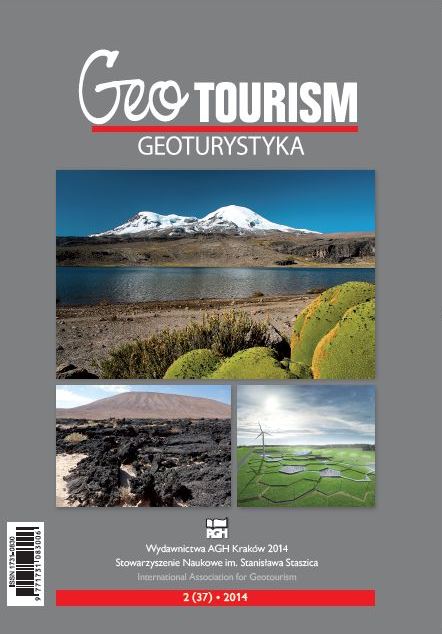The Zalew Balaton Quarry geosite in Trzebinia, southern Poland: an update of geological data
DOI:
https://doi.org/10.7494/geotour.2014.37.13Keywords:
closed quarry, Upper Jurassic, limestone, “Wielbłąd”, sarsenAbstract
A development project of the Zalew Balaton area is being presently carried out. One of the project assumptions is to create a geological path across the object. However, detailed data about the geological structure of this place is not available. For this reason, the author has researched and updated the information about the rocks occurring in the walls of the old quarry. Primarily, terrain (textural and structural analysis, layers strike and dip measurements, geological boundaries delimitation) and laboratory analysis (X-Ray Powder Diffraction, microscopic rock samples analysis) were conducted. Collected data was afterwards compared with available literature. Within the steep slopes of excavation, strong-karsted, faulted Upper Jurassic (Oxfordian) carbonate sediments were revealed. These are massive, platy and crumpled limestone. These rocks could be deposited in changing conditions of sedimentation, when calm carbonate sedimentation was disturbed by underwater gravity flows, as demonstrated by their detrital character. One of the karst funnel on the northern slope was fi lled with Oligocene sand. As a result, groundwater fl uctuations created a sarsen structure, popularly called the “Wielbłąd”. In relation to the planned geological path across the Zalew Balaton area, previous knowledge should be supplemented with new data, respectively processed and included on information panes, located within object. Plans of the path should pay attention to potential geotouristic safety, as well as to the geological values of the protected object, during its future modernization.Downloads
References
Adamczak F., Danielak B., Duda A., Bednarski M., 2012. Wstępny projekt parku miejskiego. Koncepcja parku miejskiego w Trzebini, obejmująca tereny Balatonu i Rybnej, część B. SAO Investment, Kraków.
Bogacz K., 1967. Budowa geologiczna północnego obrzeża rowu krzeszowickiego. Prace Instytutu Geologicznego, 41: 7–17.
Domańska J., 1995. Historia Zakładu Surowców Ogniotrwałych „Górka” S.A. w Trzebini. Archiwum MBP, Trzebinia.
Dudun A., 2012. O kręgach kamiennych Stonehenge i Avebury. Przegląd Geologiczny, 60 (5): 257–262.
Dżułyński S., 1952. Powstanie wapieni skalistych Jury Krakowskiej. Rocznik Polskiego Towarzystwa Geologicznego, 21: 125–180.
Felisiak J., 1992. Osady krasowe oligocenu i wczesnego miocenu oraz ich znaczenie dla poznania rozwoju i tektoniki okolic Krakowa. Annales Societatis Geologorum Poloniae, 62 (2): 173–207.
Gilewska S., 1972. Wyżyny Śląsko-Małopolskie. In: Klimaszewski M. (ed.), Geomorfologia Polski. Wydawnictwo Naukowe PWN, Warszawa: 232–339.
Głogowska M., 2007. Walory edukacyjne odsłonięć geologicznych i obiektów górniczych w Trzebini. Rozprawa doktorska. Akademia Górniczo-Hutnicza im. Stanisława Staszica w Krakowie, Wydział Geologii, Geofizyki i Ochrony Środowiska, Zakład Analiz Środowiskowych i Kartografii, Kraków: 64–80. (http://winntbg.bg.agh.edu.pl/rozprawy/9942/full9942.pdf [access: 21.03.2014].
Głogowska M., Paulo A., 2003. Geologiczna ścieżka dydaktyczna: Zalew Balaton. Urząd Miasta w Trzebini.
Hoffman M., Matyszkiewicz J., 1989. Przewodnik 60. Zjazdu Polskiego Towarzystwa Geologicznego. Kraków: 78–83.
Kubajak A., 2000. Osobliwości przyrody Trzebini. Wydawnictwo Kubajak, Krzeszowice.
Matyszkiewicz J., 1989. Przewodnik 60. Zjazdu Polskiego Towarzystwa Geologicznego. Kraków: 83–88.
Nash D.J., Ullyott J.S., 2007. Silcretes. In: Nash D.J., McLaren S.J. (eds), Geochemical Sediments and Land-scapes. Blackwell Publishing, Oxford: 95–143.
Pietrzyk-Sokulska E., Kulczycka J. (eds), 2013. Master Plan dla zbiorników Górka i Balaton. Wydawnictwo IGSMiE PAN, Kraków: 80–90.
Radomski A., 1986. Osady spływów grawitacyjnych. In: Gradziński R. (ed), Zarys sedymentologii. Wydawnictwa Geologiczne, Warszawa: 211–230.
Summerfield M.A., 1979. Origin and palaeoenvironmental interpretation of sarsens. Nature, 281: 137–139.
Ullyott J.S., Nash D.J., Whiteman C.A., Mortimore R.N., 2004. Distribution, petrology and mode of development of silcretes (Sarsens and Puddingstones) on the Eastern South Downs, UK. Earth Surface Processes and Landforms, 29: 1509–1539.
Vierek A., 1997. Geneza górnojurajskich osadów z odsłonięcia w Bydlinie. Przegląd Geologiczny, 45(4): 428–430.
Vierek A., Lewandowski J., Malik K., Salomon T., 2011. Karpaty i ich przedpole. Przewodnik do ćwiczeń terenowych z sedymentologii. Wydawnictwo Uniwersytetu Śląskiego, Katowice: 28–31.
Żero E., 1956. Szczegółowa mapa geologiczna Polski, 1:50 000, arkusz Chrzanów. Państwowy Instytut Geologiczny, Warszawa.
Websites:
http://geoportal.pgi.gov.pl/portal/page/portal/geostanowiska
http://gminyturystyczne.pl/pokaz/trzebinia
http://www.trzebinia.pl/_fi les_/zielone_perly.pdf
Downloads
Published
Issue
Section
License

The content of the journal is freely available according to the Creative Commons License Attribution 4.0 International (CC BY 4.0).


